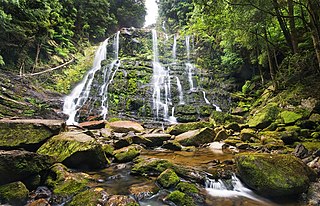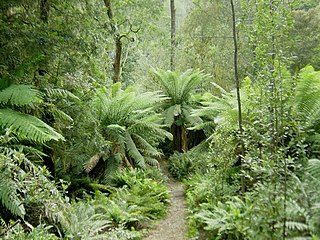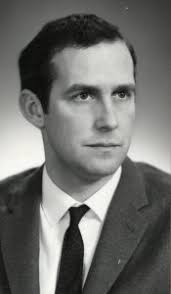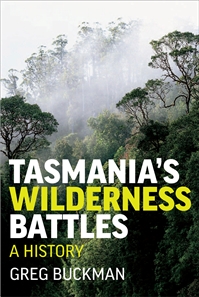
Franklin-Gordon Wild Rivers is a national park in Tasmania, 117 km west of Hobart. It is named after the two main river systems lying within the bounds of the park - the Franklin River and the Gordon River.

Robert James Brown is an Australian former politician, medical doctor and environmentalist. He was a senator and the parliamentary leader of the Australian Greens. Brown was elected to the Australian Senate on the Tasmanian Greens ticket, joining with sitting Greens Western Australia senator Dee Margetts to form the first group of Australian Greens senators following the 1996 federal election. He was re-elected in 2001 and in 2007. He was the first openly gay member of the Parliament of Australia and the first openly gay leader of an Australian political party.

The Franklin River is a major perennial river located in the Central Highlands and western regions of Tasmania, Australia. The river is located in the Franklin-Gordon Wild Rivers National Park at the mid northern area of the Tasmanian Wilderness World Heritage Area. Its source is situated at the western edge of the Central Highlands and it flows west towards the West Coast.

Lake Pedder, once a glacial outwash lake, is a man-made impoundment and diversion lake located in the southwest of Tasmania, Australia. In addition to its natural catchment from the Frankland Range, the lake is formed by the 1972 damming of the Serpentine and Huon rivers by the Hydro Electric Commission of Tasmania for the purposes of hydroelectric power generation.

The Gordon-below-Franklin Dam project was a proposed dam on the Gordon River in Tasmania, Australia, that was never constructed. The movement that eventually led to the project's cancellation became one of the most significant environmental campaigns in Australian history.

The Gordon River is a major perennial river located in the central highlands, south-west, and western regions of Tasmania, Australia.

Hydro Tasmania, known for most of its history as the Hydro-Electric Commission (HEC) or The Hydro, is the trading name of the Hydro-Electric Corporation, a Tasmanian Government business enterprise which is the predominant electricity generator in the state of Tasmania, Australia. The Hydro was originally oriented towards hydro-electricity, due to Tasmania's dramatic topography and relatively high rainfall in the central and western parts of the state. Today Hydro Tasmania operates thirty hydro-electric and one gas power station, and is a joint owner in three wind farms.

Christine Anne Milne is an Australian politician who served as a Senator for Tasmania. She was the leader of the parliamentary caucus of the Australian Greens from 2012 to 2015. Milne stepped down as leader on 6 May 2015, replaced by Richard Di Natale.

The Wilderness Society is an Australian, community-based, not-for-profit non-governmental environmental advocacy organisation.

Commonwealth v Tasmania was a significant Australian court case, decided in the High Court of Australia on 1 July 1983. The case was a landmark decision in Australian constitutional law, and was a significant moment in the history of conservation in Australia. The case centred on the proposed construction of a hydro-electric dam on the Gordon River in Tasmania, which was supported by the Tasmanian government, but opposed by the Australian federal government and environmental groups.

The Tarkine, officially takayna / Tarkine, is an area containing the Savage River National Park in the north west Tasmania, Australia, which contains significant areas of wilderness. The Tarkine is noted for its beauty and natural values, containing the largest area of Gondwanan cool-temperate rainforest in Australia, as well as for its prominence in Tasmania's early mining history. The area's high concentration of Aboriginal sites has led to it being described by the Australian Heritage Council as "one of the world's great archaeological regions".

Douglas Ackley Lowe AM was the 35th Premier of Tasmania, from 1 December 1977 to 11 November 1981. His time as Premier coincided with controversy over a proposal to build a dam on Tasmania's Gordon River, which would have flooded parts of the Franklin River. The ensuing crisis saw Lowe overthrown as Premier and resign from the Labor Party, acting as an independent for the remainder of his political career.
The Tasmanian Wilderness Society was a Tasmanian environmental group that started in 1976 in response to a proposal by the state's Hydro Electric Commission to construct a dam on the Gordon River, downstream from the Franklin River, that led to the Franklin Dam controversy. The group evolved from membership of the South West Tasmania Action Committee and members of the United Tasmania Group. It was active in public protest about the issues of Wilderness, the Franklin River and South West Tasmania.

The Tarraleah Power Station is a hydroelectric power station located in the Central Highlands region of Tasmania, Australia. The power station is part of the Upper Derwent hydro scheme and is operated by Hydro Tasmania.
The Labor–Green Accord was a 1989 political agreement between the Labor Party and the Tasmanian Greens to form government in the Australian state of Tasmania after the 1989 general election had resulted in a hung parliament.
The Tasmanian power referendum was a one-question referendum held on 12 December 1981, and intended to determine the location of a proposed hydroelectricity dam to be built on the Gordon River in Tasmania, Australia.
Brenda Hean (1910-1972) was a member of the Lake Pedder Action Committee (LPAC) and a resident of Hobart, Tasmania who disappeared at the time of the flooding of Lake Pedder.
The Lake Pedder Action Committee was a Tasmanian environmental group.

Beginning as a conservation movement, the environmental movement in Australia was the first in the world to become a political movement. Australia is home to United Tasmania Group, the world's first green party.
Helen Gee was an Australian author, editor, conservationist and environmental activist.














